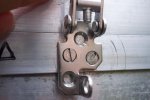Putting them on the inside creates a problem as they then interfere with the fabric sides that have to be pulled inwards so as not to foul the seal. Putting the clips on the outside serves two functions - helps to locate the edge of the top lid in the correct place against the back of the clips, and will also enable temporary hard sides to be clipped in at some point, using the clip halves with a second clip pair on the temporary side sections.
I WILL have a locking mechanism inside probably connected to a pair of metal struts that will swing up to support the roof when lifted, thus taking the pressure off the gas struts and giving a solid metal 'corner' around which the fabric will bend to give good tight non-flappy tension. These metal corners will also incorporate a 'handle' running across the width of the vehicle just inside near the back door, which will be used to grab hold of to push up the roof, and later pull it back down again.
However when the roof is in the up position any weight on this 'handle' will be transferred down to the vehicle frame into the gutter area which is immensely strong so this means it can be used to pull oneself up into the sleeping area without putting undue pressure on the gas struts nor the lifting roof structure.
EDIT: I'm trying for accuracy with this build but given that I'm doing most of it on the drive, sometimes in the rain (and snow last week) its obviously limiting, however I've tried to build in 'escape routes' for aspects that may be problematic such as seals and alignment. That's what I'm just in from wrestling with - the welding has caused a slight bowing (outwards) of one of the sides of the lifting lid, so to remedy it I've put a large sash clamp on the edge with a piece of 2x1 each side and bent it around a bit. It's helped, but may require more tweaking.









